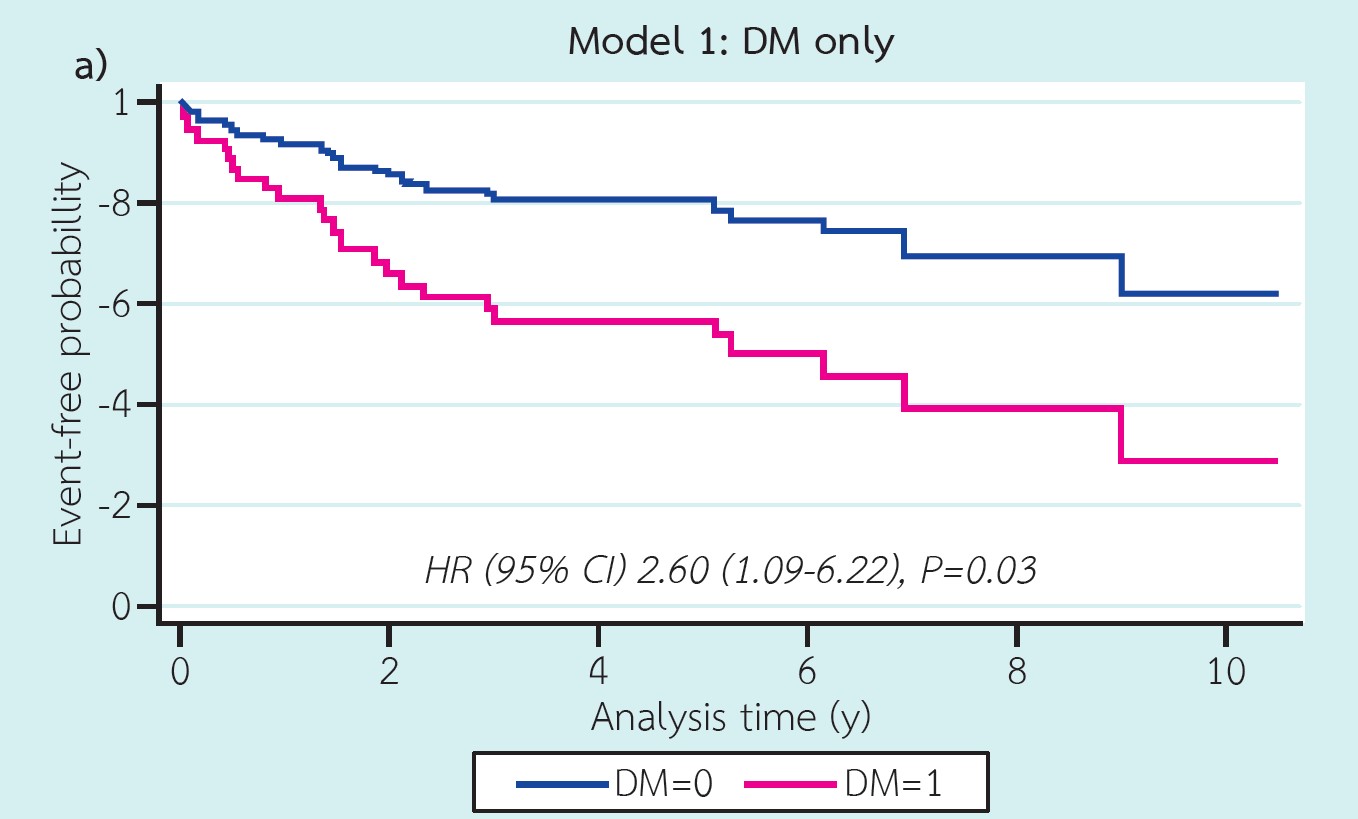Renal outcomes in membranous nephropathy with preexisting diabetes mellitus
Main Article Content
Abstract
Background: Previous studies have described prognostic factors for worse renal outcomes in membranous nephropathy (MN). The impact of preexisting diabetes mellitus (DM) on renal outcomes in membranous nephropathy is less well characterized. The present study explored the influence of preexisting DM on renal outcomes in patients with MN.
Methods: This is a single-center retrospective cohort study that included all adult patients with biopsy proven MN between 1 January 2001 to 31 December 2020. Patients were categorized into 2 groups according to the presence or the absence of DM. The composite outcomes of end-stage kidney disease, the decline in estimated glomerular filtration rate ≥40% and death due to renal causes were compared between the 2 groups.
Results: A total of 114 patients with biopsy proven MN were identified. Most patients (70%) were diagnosed with idiopathic MN. Sixteen patients (14%) had preexisting DM. Diabetic patients were older (60.6±10.5 years vs. 51.1±16.2 years, P=0.025) and had lower prevalence of hypertension (2% vs 50%, P=0.005). At baseline, the amount of urine protein, pathological findings, and the rate of remission were not significantly different between the two groups. The median follow-up time was 2.9 years. The composite renal outcomes occurred in 27 patients (18.8%). Univariate cox proportional hazards regression analysis revealed pre-existing DM as a predictor of higher composite renal outcomes (Hazard Ratio: 2.60; 95% CI: 1.09-6.22; P=0.032). The association between preexisting DM and outcome was lost after adjustments for age, sex, hypertension and renal remission status (Hazard Ratio: 2.24; 95% CI: 0.89–5.67; P= 0.09). Subgroup analysis according to the etiologies of MN demonstrated that pre-existing DM was a predictor of poor renal outcome among idiopathic MN (Hazard Ratio: 3.27; 95% CI: 1.22 – 8.78; P = 0.019) but not in secondary MN.
Conclusion: Preexisting DM in patients with MN might be associated with worse long-term renal outcomes. A larger population-based study is required to ascertain these findings.
Article Details

This work is licensed under a Creative Commons Attribution-NonCommercial-NoDerivatives 4.0 International License.
This article is published under CC BY-NC-ND 4.0 license, which allows for non-commercial reuse of the published paper as long as the published paper is fully attributed. Anyone can share (copy and redistribute) the material in any medium or format without having to ask permission from the author or the Nephrology Society of Thailand.
References
Cattran DC, Brenchley PE. Membranous nephropathy: integrating basic science into improved clinical management. Kidney Int. 2017;91(3):566-74.
Parichatikanond P, Chawanasuntorapoj R, Shayakul C, Choensuchon B, Vasuvattakul S, Vareesangthip K, et al. An analysis of 3,555 cases of renal biopsy in Thailand. J Med Assoc Thai. 2006;89 Suppl 2:S106-11.
Beck LH, Bonegio RGB, Lambeau G, Beck DM, Powell DW, Cummins TD, et al. M-Type Phospholipase A2 Receptor as Target Antigen in Idiopathic Membranous Nephropathy. New England Journal of Medicine. 2009;361(1):11-21.
Glassock RJ. Diagnosis and natural course of membranous nephropathy. Semin Nephrol. 2003;23(4):324-32.
Cattran DC, Kim ED, Reich H, Hladunewich M, Kim SJ. Membranous Nephropathy: Quantifying Remission Duration on Outcome. J Am Soc Nephrol. 2017;28(3):995-1003.
Reichert LJ, Koene RA, Wetzels JF. Prognostic factors in idiopathic membranous nephropathy. Am J Kidney Dis. 1998;31(1):1-11.
Sprangers B, Bomback AS, Cohen SD, Radhakrishnan J, Valeri A, Markowitz GS, et al. Idiopathic membranous nephropathy: clinical and histologic prognostic features and treatment patterns over time at a tertiary referral center. Am J Nephrol. 2012;36(1):78-89.
Brancati FL, Whelton PK, Randall BL, Neaton JD, Stamler J, Klag MJ. Risk of End-stage Renal Disease in Diabetes Mellitus: A Prospective Cohort Study of Men Screened for MRFIT. JAMA. 1997;278(23):2069-74.
Koye DN, Shaw JE, Reid CM, Atkins RC, Reutens AT, Magliano DJ. Incidence of chronic kidney disease among people with diabetes: a systematic review of observational studies. Diabet Med. 2017;34(7):887-901.
Lea JP, Nicholas SB. Diabetes mellitus and hypertension: key risk factors for kidney disease. J Natl Med Assoc. 2002;94(8 Suppl):7S-15S.
Liu D, Huang T, Chen N, Xu G, Zhang P, Luo Y, et al. The modern spectrum of biopsy-proven renal disease in Chinese diabetic patients-a retrospective descriptive study. PeerJ. 2018;6:e4522-e.
https://www.nephrothai.org/wp-content/uploads/2022/06/Final-TRT-report-2020.pdf
Huh H, Lee H, Lee JP, Kim DK, Oh S, Oh YK, et al. Factors affecting the long-term outcomes of idiopathic membranous nephropathy. BMC Nephrology. 2017;18(1):104.
Wehrmann M, Bohle A, Bogenschütz O, Eissele R, Freislederer A, Ohlschlegel C, et al. Long-term prognosis of chronic idiopathic membranous glomerulonephritis. An analysis of 334 cases with particular regard to tubulo-interstitial changes. Clin Nephrol. 1989;31(2):67-76.
Vittinghoff E, McCulloch CE. Relaxing the rule of ten events per variable in logistic and Cox regression. Am J Epidemiol. 2007;165(6):710-8.
Xie Z, Li Z, Dong W, Chen Y, Li R, Wu Y, et al. The impact of coexisting diabetes mellitus on clinical outcomes in patients with idiopathic membranous nephropathy: a retrospective observational study. BMC Nephrology. 2020;21(1):224.
Toth-Manikowski S, Atta MG. Diabetic Kidney Disease: Pathophysiology and Therapeutic Targets. J Diabetes Res. 2015;2015:697010-.
Bhadauria D, Chellappan A, Kaul A, Etta P, Badri V, Kumar Sharma R, et al. Idiopathic membranous nephropathy in patients with diabetes mellitus: a diagnostic and therapeutic quandary! Clin Kidney J. 2018;11(1):46-50.


